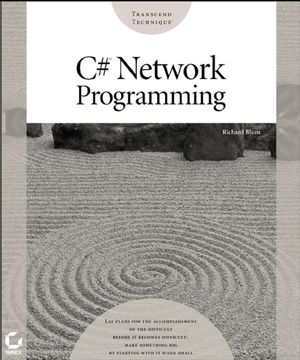C# Network ProgrammingISBN: 978-0-7821-4176-4
672 pages
December 2002
|
Description
This book helps newcomers get started with a look at the basics of network programming as they relate to C#, including the language's network classes, the Winsock interface, and DNS resolution. Spend as much time here as you need, then dig into the core topics of the network layer. You'll learn to make sockets connections via TCP and "connectionless" connections via UDP. You'll also discover just how much help C# gives you with some of your toughest chores, such as asynchronous socket programming, multithreading, and multicasting.
Network-layer techniques are just a means to an end, of course, and so this book keeps going, providing a series of detailed application-layer programming examples that show you how to work with real protocols and real network environments to build and implement a variety of applications. Use SNMP to manage network devices, SMTP to communicate with remote mail servers, and HTTP to Web-enable your applications. And use classes native to C# to query and modify Active Directory entries.
Rounding it all out is plenty of advanced coverage to push your C# network programming skills to the limit. For example, you'll learn two ways to share application methods across the network: using Web services and remoting. You'll also master the security features intrinsic to C# and .NET--features that stand to benefit all of your programming projects.
Table of Contents
Part I: Network Programming Basics.
Chapter 1: The C# Language.
Chapter 2: IP Programming Basics.
Chapter 3: C# Network Programming Classes.
Chapter 4: DNS and C#.
Part II: Network Layer Programing.
Chapter 5: Connection-Oriented Sockets.
Chapter 6: Connectionless Sockets.
Chapter 7: Using The C# Sockets Helper Classes.
Chapter 8: Asynchronous Sockets.
Chapter 9: Using Threads.
Chapter 10: IP Multicasting.
Part III: Application Layer Programming Examples.
Chapter 11: ICMP.
Chapter 12: SNMP.
Chapter 13: SMTP.
Chapter 14: HTTP.
Chapter 15: Active Directory.
Chapter 16: Remoting.
Chapter 17: Security.
Index.
Author Information
Downloads
| Download Title | Size | Download |
|---|---|---|
| Download All Code Used in the Book Download a .zip file with all the code and examples used in the book. To uncompress the file, Windows users can use Windows built-in ZIP utilities or a 3rd party utility like WinZip or WinRAR. Macintosh users can simply double-click the downloaded file to extract using the built-in archive utility. |
78.96 KB | Click to Download |
Errata
Do you think you've discovered an error in this book? Please check the list of errata below to see if we've already addressed the error. If not, please submit the error via our Errata Form. We will attempt to verify your error; if you're right, we will post a correction below.
| Chapter | Page | Details | Date | Print Run |
|---|---|---|---|---|
| Combined Errata Page 11 Under Downloading and Installing the C# Runtime Package, second paragraph, last word in the last sentence should read "dotnetfx.exe"
Page 35 Second half of listing 1.6, first printed line, should read FileAccess.ReadWrite);
Page 439 2nd para., at the end of the 3rd line "...formats the IP packet use with..." , should be "...formats the IP packet used with..."
Page 488 code snippet, in the catch block, in the Console.WriteLine method, there should be a space after "Windows 2000".
Page 493 Listing 13.2 (11th Line in the code) initialization of mm.CC doesn't have an ending quotation and a semi-colon to end the statement.
Page 504 Listing 13.4 (codeline 10) missing colon (to indicate inheritance from Form class)
|











